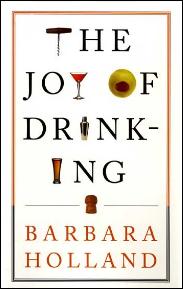|
Energy Drink Is Withdrawn Over Concerns About Name
from:
The New York Times
8 May 2007
Associated Press
An energy drink called Cocaine has been withdrawn from stores nationwide amid concerns about its name, the company that produces it said yesterday.…
The Food and Drug Administration issued a warning letter last month that said that [the company] was illegally marketing the drink as a street drug alternative and a dietary supplement.…
The FDA cited as evidence the drink's labeling and Web site, which included the statements "Speed in a Can," Liquid Cocaine," and "Cocaine—Instant Rush."…
Users of the drink responded to the announcement by leaving dozens of messages, many of them profanity-laced, on a page created for the product on the social networking site MySpace.com.…
|
|
 |
|
|
|
from:
The Joy of Drinking
by Barbara Holland
Bloomsbury © 2007
Drink, the social glue of the human race. Probably in the beginning we could explain ourselves to our close family members with grunts, muttered syllables, gestures, slaps, and punches. Then when the neighbors started dropping in to help harvest, stomp, stir and drink the bounty of the land, after we'd softened our natural suspicious hostility with a few stiff ones, we had to think up some nuanced communication, like words. From there it was a short step to grammar, civil law, religion, history, and "The Whiffenpoof Song."
It's almost impossible to believe now, with limitless professional amusement at our fingertips, but for many thousands of years the only entertainment people had was other people. Now we can avoid our fellow humans completely for weeks, companioned only by electronics, and have a fine time, but for millennia we had to put up with people and their jokes, their long boring stories, their boasts and card tricks and primitive musical instruments, or spend the evening staring at the wall.
Alcohol helped.… p. 12
We owe our classic modern description [of a hangover] to Kingsley Amis's Lucky Jim: "The light did him harm, but not as much as looking at things did; he resolved, having done it once, never to move his eyeballs again. A dusty thudding in his head made the scene before him beat like a pulse. His mouth had been used as a latrine by some small creature of the night, and then as a mausoleum. During the night, too, he'd somehow been on a cross-country run and then been expertly beaten up by the secret police. He felt bad." p. 101
|
|
|
|
One Man's Trash is Another Man's Two-Bit 'Trashball'
by Ariel Sabar
from:
The New York Times
29 April 2007
Christopher Goodwin doesn't collect trash. He curates it.
Many afternoons find Mr. Goodwin kneeling on some gritty sidewalk here, appraising a faded A.T.M. receipt, a tuft of dryer lint, the scraps of a torn-up letter. Neat streets he doesn't mess with. His own neighborhood is a bore, "It's obscenely clean, " he says dismissively.
Litter speaks to Mr. Goodwin, 37, a studiously disheveled art school dropout, and, to his patrons, apparently, who drop their quarters in a couple of gumball machines around town that dispense plastic capsules containing pieces of trash personally selected by the artist.…
Though some admirers see Trashball as a critique of America's wasteful ways, Mr. Goodwin views it as archeology, a divination of who people are from what they leave behind, even if it is just because they are too lazy to toss it in a wastebasket.…
|
|
|